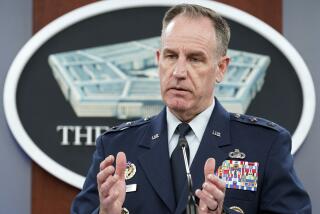Nuclear Arms Buildup Cost U.S. $4 Trillion, Study Says : Defense: Brookings Institution report contends financing of stockpile was kept from public. It attacks the idea that the weapons provided cheap deterrent.
- Share via
WASHINGTON — The nuclear arms race has cost the United States nearly $4 trillion, a staggering financial toll that was never disclosed to the American public, according to a major study unveiled Tuesday by the Brookings Institution.
The study attacks the Cold War wisdom that nuclear weapons provided the nation with a cheap way to deter its enemies after detonation of the first atomic bomb 50 years ago this Sunday in New Mexico.
“There was a presumption that nuclear weapons gave the biggest bang for the buck, but nobody was counting the bucks,” said Arjun Makhijani, a nuclear-waste expert who participated in the study. “What got counted officially was just 10% of the real cost.”
The study marks the first systematic effort to tabulate the cost of nuclear weapons and their delivery systems, as well as the vast spending on related technologies that never resulted in deployed weapons.
The report’s authors contended that the size of the U.S. nuclear stockpile--and its subsequent cost--were determined arbitrarily, fueled by interservice rivalries in the military, pork-barrel politics in Congress and broad governmental secrecy that kept the true costs of the buildup hidden from the public.
The actual cost of producing roughly 70,000 nuclear bombs since World War II was only a small part of a much larger strategic effort to build missiles, bombers and the sophisticated national control systems that put forces on 24-hour nuclear alert, the study stated.
An estimated $375 billion was spent on the bombs; $15 billion on decommissioning the bombs; $25 billion on secrecy, security and arms control; $2 trillion on delivery systems, and $1.1 trillion on command systems and air defenses. In addition, an estimated $385 billion will be spent to clean up radioactive wastes created by the arms race.
Investments of $75 billion were made in technologies and programs that were abandoned, including missiles, reactors, bombers and communications systems. The government spent, for example, $6 billion on development of a nuclear-powered aircraft engine for bombers and $700 million on research for peaceful nuclear explosions, according to the report.
At its 1960s peak, the United States was producing 25 nuclear weapons per day and by 1967 had a stockpile of 32,500 bombs. To keep the production process stoked, the nation was operating 925 uranium mines.
Among the other costs identified in the study: $89 million in legal fees fighting lawsuits against nuclear testing and contamination, $15 million paid to Japan as compensation for fallout from the 1954 Bravo nuclear test and $172 million paid to U.S. citizens in compensation for radiation exposure.
Dan Reicher, deputy chief of staff at the Energy Department, said the agency had looked over the report and concluded that the estimates pertaining to the Energy Department were “in the right ballpark.”
In hindsight, the study’s authors contend that the oversized nuclear arsenal was a product of unrealistic military thinking about its potential use. They cited, for example, a now-declassified Army document that projected a European land war would require the use of up to 400 nuclear weapons per day.
But some nuclear experts took sharp exception to the report’s underlying suggestion that waste was rampant and that much of the nuclear buildup was unnecessary.
“I don’t think we had any choice,” said Charles Herzfeld, a former senior Pentagon official and a consultant to the Los Alamos National Laboratory. “People who say otherwise are engaging in revisionist history of the most extreme sort.”
Herzfeld agreed that the costs were high, but added: “It bought peace. It bought ultimate victory. We may not know we won, but the Soviets know they lost. To not have had a major war was a very big accomplishment.”
More to Read
Sign up for Essential California
The most important California stories and recommendations in your inbox every morning.
You may occasionally receive promotional content from the Los Angeles Times.














